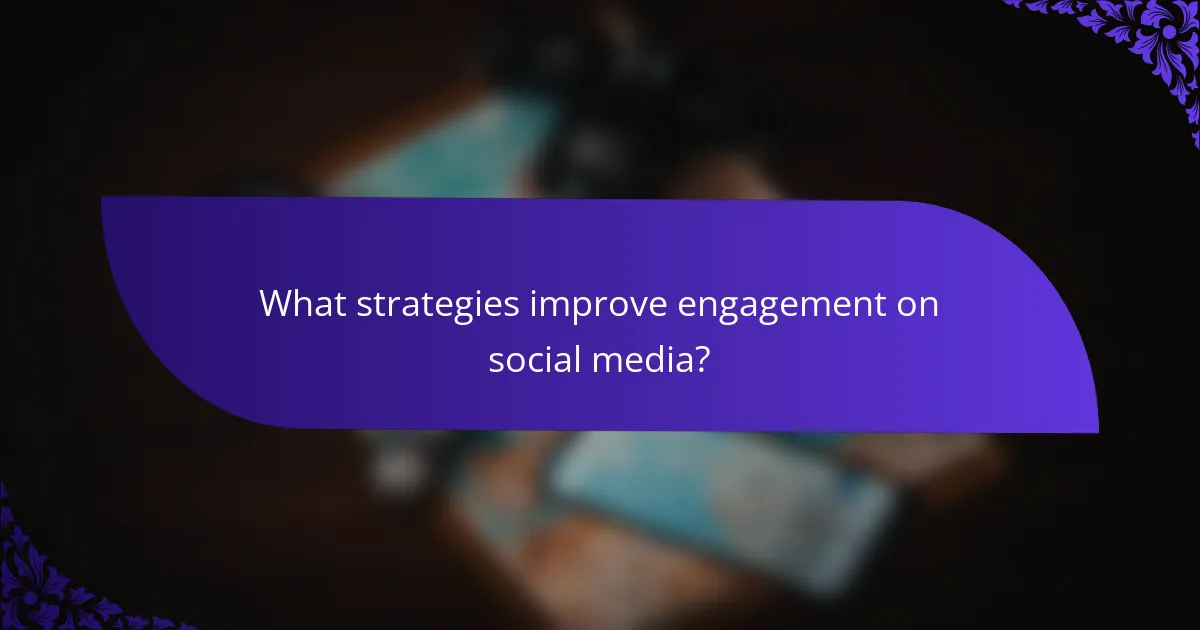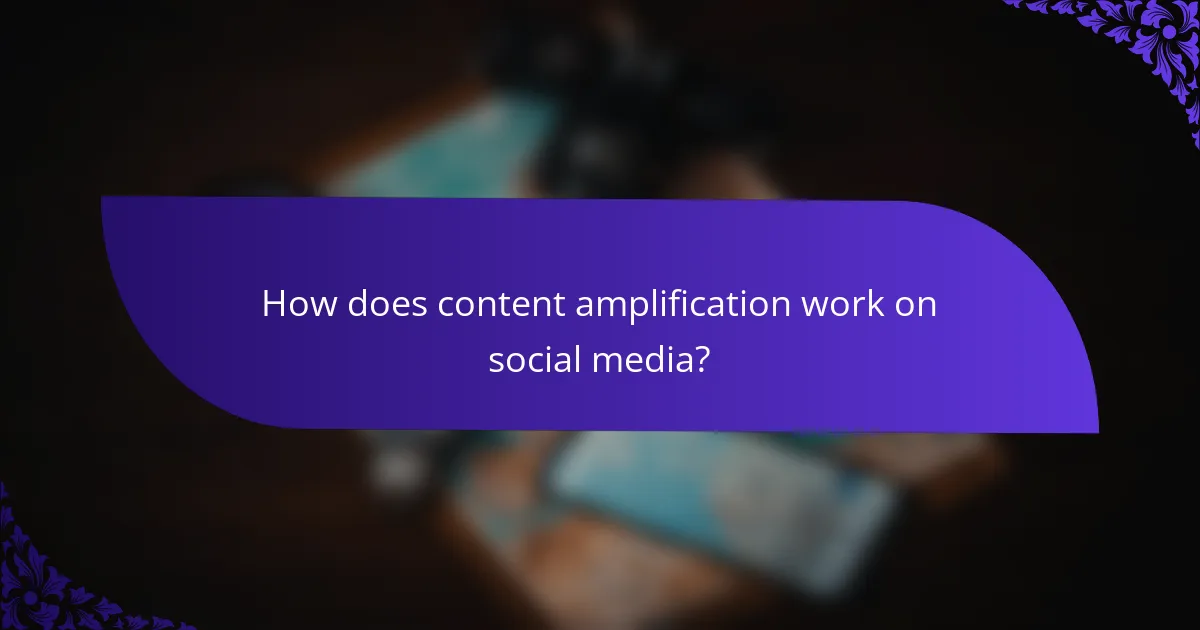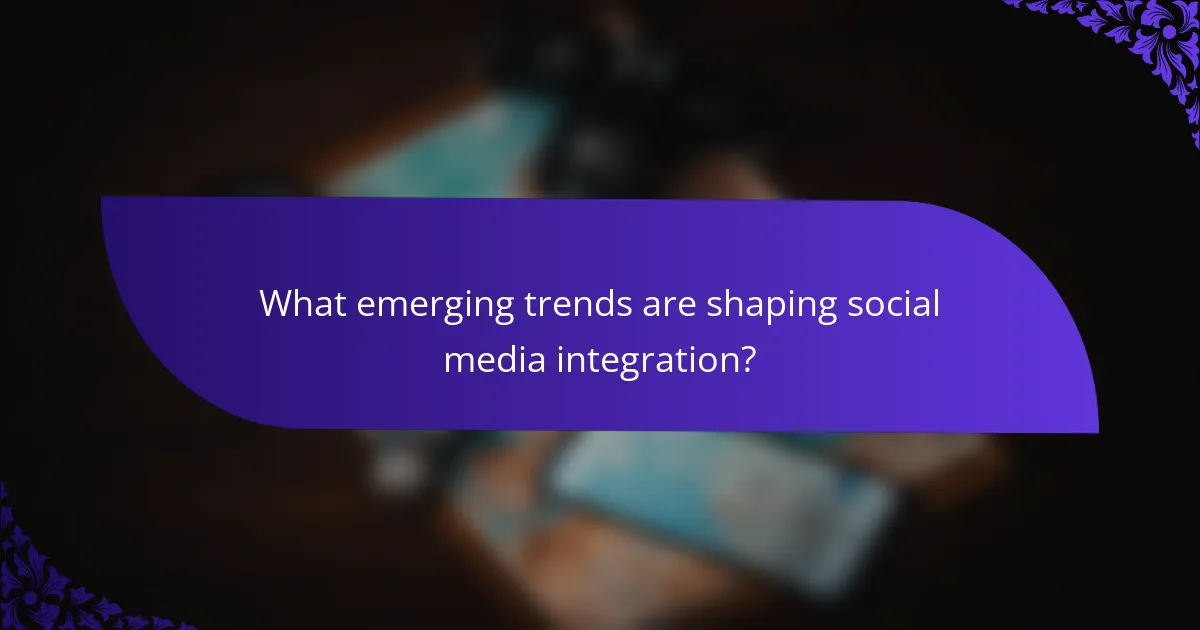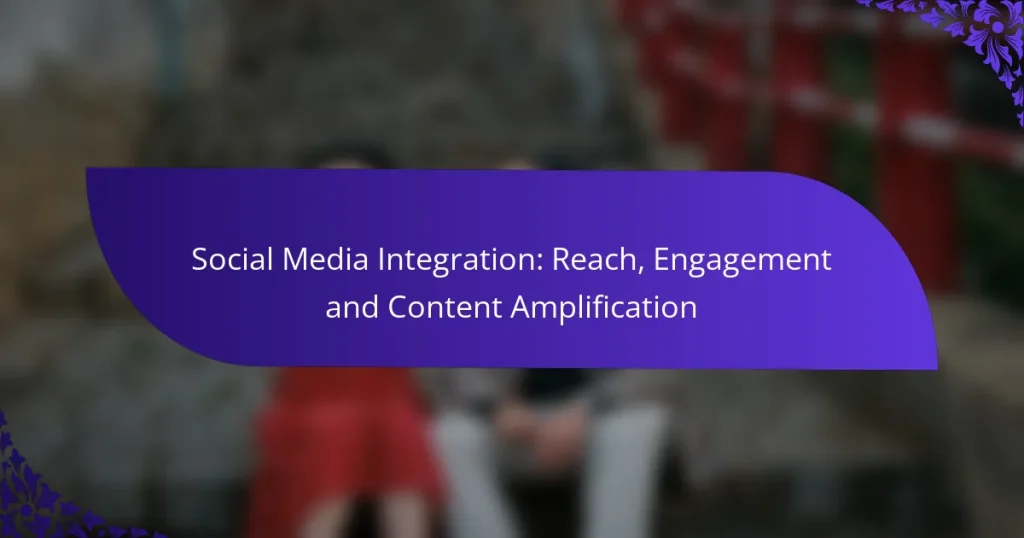Social media integration plays a crucial role in expanding audience reach by enabling content sharing across various platforms, which attracts a wider range of users. By fostering engagement through interactive features and targeted campaigns, brands can create personalized experiences that resonate with their audience. Additionally, strategies for content amplification, such as leveraging influencers and utilizing hashtags, further enhance visibility and discoverability of posts.

How can social media integration enhance audience reach?
Social media integration can significantly enhance audience reach by allowing content to be shared across multiple platforms, thereby attracting diverse user groups. This approach not only broadens visibility but also fosters engagement through interactive features and targeted campaigns.
Increased visibility through cross-platform sharing
Cross-platform sharing enables content to be disseminated across various social media channels, increasing its visibility. For instance, a blog post shared on Facebook, Twitter, and Instagram can reach different audience segments, maximizing exposure.
To effectively implement cross-platform sharing, ensure that content is tailored to fit the unique characteristics of each platform. This may include adjusting image sizes, captions, and hashtags to optimize engagement.
Targeted advertising for specific demographics
Targeted advertising allows businesses to reach specific demographics based on user data, interests, and behaviors. By leveraging social media platforms’ advertising tools, companies can create tailored ads that resonate with particular audience segments.
Consider using A/B testing to refine your ads and identify which messages perform best. This approach can lead to higher conversion rates and a better return on investment (ROI) for advertising spend.
Utilizing analytics for audience insights
Analytics tools provide valuable insights into audience behavior, preferences, and engagement patterns. By analyzing metrics such as click-through rates, shares, and comments, businesses can better understand what content resonates with their audience.
Regularly review analytics to adjust your social media strategy. Look for trends over time and be prepared to pivot your approach based on audience feedback and engagement levels. This proactive strategy can enhance overall reach and effectiveness.

What strategies improve engagement on social media?
To enhance engagement on social media, focus on creating interactive and personalized experiences for users. Strategies such as using interactive content formats, hosting live streaming events, and tailoring content to user preferences can significantly boost interaction and connection.
Interactive content formats like polls and quizzes
Interactive content formats, such as polls and quizzes, encourage users to participate actively rather than passively consuming information. These formats can increase engagement by inviting users to share their opinions or test their knowledge, making them feel more connected to the brand.
For example, a brand might create a fun quiz related to its products or services, allowing users to discover which item suits them best. This not only entertains but also drives traffic to the website, as users often share their results on their own social media profiles.
Live streaming events for real-time interaction
Live streaming events provide a platform for real-time interaction between brands and their audience. These events can include Q&A sessions, product launches, or behind-the-scenes looks, fostering a sense of community and immediacy.
Brands should consider scheduling regular live streams to keep their audience engaged. Promoting these events in advance and encouraging viewers to ask questions can lead to higher participation rates and a more vibrant online community.
Personalized content based on user preferences
Personalized content is tailored to meet the specific interests and preferences of individual users, making it more relevant and engaging. By analyzing user data, brands can create targeted posts that resonate with their audience, increasing the likelihood of interaction.
For instance, using insights from social media analytics, a brand can segment its audience and deliver customized messages, such as special offers or content that aligns with their interests. This approach not only enhances engagement but also builds loyalty, as users feel valued and understood.

How does content amplification work on social media?
Content amplification on social media involves increasing the visibility and reach of posts through various strategies. This can include leveraging influencers, creating engaging content, and utilizing hashtags to enhance discoverability.
Utilizing influencers for broader reach
Influencers can significantly expand your content’s reach by sharing it with their established audiences. Collaborating with influencers who align with your brand values can lead to authentic engagement and higher conversion rates.
When selecting influencers, consider their follower demographics and engagement rates. Micro-influencers, for example, often have more engaged audiences compared to larger accounts, making them a cost-effective option for brands.
Creating shareable content that resonates
To create shareable content, focus on producing high-quality visuals and compelling narratives that resonate with your target audience. Content that evokes strong emotions or provides valuable information tends to be shared more frequently.
Consider using formats like infographics, videos, or interactive posts, as these are more likely to capture attention. A good rule of thumb is to ensure your content is easily digestible and encourages users to share it with their networks.
Leveraging hashtags for discoverability
Hashtags enhance the discoverability of your content by categorizing it within relevant topics. Using popular and niche hashtags can help your posts reach a broader audience and connect with users interested in those themes.
Research trending hashtags in your industry and incorporate a mix of general and specific tags. Aim for a balance; using too many can appear spammy, while too few may limit your reach. A practical approach is to use around three to five relevant hashtags per post.

What are the best tools for social media integration?
The best tools for social media integration streamline your content distribution, enhance engagement, and provide valuable analytics. These platforms help you manage multiple accounts efficiently, automate tasks, and analyze performance across various channels.
Hootsuite for scheduling and analytics
Hootsuite is a comprehensive tool that allows you to schedule posts across various social media platforms, including Facebook, Twitter, and Instagram. It offers robust analytics features to track engagement metrics, helping you understand what content resonates with your audience.
When using Hootsuite, consider creating a content calendar to plan your posts in advance. This approach can help maintain a consistent posting schedule and improve audience engagement. Be aware of the varying peak times for different platforms to maximize reach.
Buffer for content management
Buffer is designed for easy content management, allowing you to curate and share content across multiple social media channels. Its user-friendly interface makes it simple to add posts, analyze performance, and adjust strategies based on real-time data.
Utilize Buffer’s features to create a posting schedule that aligns with your audience’s online activity. Regularly review the analytics to identify high-performing content and adjust your approach accordingly. Avoid over-scheduling, as this can lead to audience fatigue.
Zapier for automation between platforms
Zapier is an automation tool that connects different applications, enabling seamless workflows between social media platforms and other tools. For example, you can set up a Zap to automatically share new blog posts on your social media accounts, saving time and ensuring consistency.
To make the most of Zapier, explore its extensive library of integrations and create Zaps that align with your specific needs. Be cautious with automation; ensure that your posts maintain a personal touch and engage your audience effectively. Regularly review your Zaps to optimize performance and adapt to changing needs.

What criteria should be considered for effective social media integration?
Effective social media integration requires a strategic approach that aligns with brand messaging and understands the unique characteristics of each platform’s audience. By focusing on these criteria, businesses can enhance their reach, engagement, and content amplification.
Alignment with brand messaging
Ensuring that social media efforts align with brand messaging is crucial for maintaining consistency and building trust. This means that all posts, visuals, and interactions should reflect the brand’s voice, values, and overall mission.
To achieve alignment, create a style guide that outlines tone, language, and visual elements. Regularly review content to ensure it adheres to this guide. For example, a luxury brand should use sophisticated language and high-quality visuals, while a casual brand might adopt a more relaxed tone.
Understanding platform-specific audiences
Each social media platform attracts different demographics and user behaviors, making it essential to tailor content accordingly. Understanding these nuances helps in crafting messages that resonate with the target audience on each platform.
For instance, Instagram is popular among younger users and favors visually appealing content, while LinkedIn caters to professionals and is better suited for industry insights and networking. Analyze audience data and engagement metrics to refine your approach and maximize impact.

What emerging trends are shaping social media integration?
Emerging trends in social media integration are primarily driven by advancements in technology and user behavior. Key trends include AI-driven content personalization, increased focus on privacy, and the rise of short-form video content, all of which significantly impact how brands engage with their audiences.
AI-driven content personalization
AI-driven content personalization tailors social media experiences to individual users based on their preferences and behaviors. By analyzing data such as user interactions, demographics, and interests, brands can deliver highly relevant content that resonates with their target audience.
To effectively implement AI-driven personalization, companies should invest in robust analytics tools that can track user engagement and preferences. This approach allows for dynamic content adjustments, ensuring that users receive the most pertinent information, which can improve engagement rates significantly.
Brands should be cautious, however, as overly personalized content can lead to privacy concerns. Striking a balance between personalization and user privacy is crucial, so always provide users with clear options to manage their data preferences. Regularly review and update your strategies to align with evolving regulations and user expectations.


